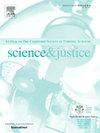Advancing forensic firearm examination protocol: Shotgun firing pin impressions
IF 1.9
4区 医学
Q2 MEDICINE, LEGAL
引用次数: 0
Abstract
The theory of forensic firearm examination relies on the assumption that of the two contacting surfaces, the harder surface leaves marks on the softer one. The class and individual characteristics left by firearm parts undergo change due to several key variables, including the ammunition, and the firearm themselves. Notably, the characteristics are subject to distinct or permanent change during the first few fires immediately after manufacturing. In contrast, alterations arising from the many other factors associated with the shooting process tend to develop with slight variations. Using four different shotgun, this study examined the distinct changes observed in the individual characteristics formed by firing pins on fired shotshell cases. Understanding the manufacturing processes and conducting elemental analysis on the firing pins was necessary during this examination. The choice of material used to construct the shotgun firing pin appears to be the main reason for the inconsistent and changing marks observed on the fired shotshell cases. Although the changing individual characteristics within firing pin impressions could hinder the forensic comparison and examination of the shotgun, this study demonstrates how an integrated, holistic approach can overcome this challenge through the comparison and analysis of other firearm parts’ marks. This study contributes to the scientific understanding of forensic firearm examination by evidencing the contribution and importance of the firearm part’s material composition and the need to document the part’s surface prior to test firing.
先进的法医枪支检查程序:霰弹枪的弹孔印
法医枪支检验理论依赖于两个接触表面的假设,较硬的表面在较软的表面上留下痕迹。枪支部件留下的类别和个体特征由于几个关键变量而发生变化,包括弹药和枪支本身。值得注意的是,在制造后的最初几次火灾中,这些特性会发生明显或永久的变化。相比之下,由与拍摄过程相关的许多其他因素引起的变化往往以轻微的变化发展。使用四种不同的霰弹枪,本研究检查了射击弹壳上的击发针形成的个体特征的明显变化。在这次检查中,有必要了解制造过程并对发针进行元素分析。制造猎枪射击销的材料的选择似乎是在发射后的弹壳上观察到不一致和变化的痕迹的主要原因。尽管击发针印痕中不断变化的个体特征可能会阻碍对霰弹枪的法医比较和检查,但本研究表明,通过比较和分析其他枪支部件的印痕,一种综合的、整体的方法可以克服这一挑战。本研究通过证明枪支部件材料组成的贡献和重要性以及在测试射击之前记录部件表面的必要性,有助于科学地理解法医枪支检查。
本文章由计算机程序翻译,如有差异,请以英文原文为准。
求助全文
约1分钟内获得全文
求助全文
来源期刊

Science & Justice
医学-病理学
CiteScore
4.20
自引率
15.80%
发文量
98
审稿时长
81 days
期刊介绍:
Science & Justice provides a forum to promote communication and publication of original articles, reviews and correspondence on subjects that spark debates within the Forensic Science Community and the criminal justice sector. The journal provides a medium whereby all aspects of applying science to legal proceedings can be debated and progressed. Science & Justice is published six times a year, and will be of interest primarily to practising forensic scientists and their colleagues in related fields. It is chiefly concerned with the publication of formal scientific papers, in keeping with its international learned status, but will not accept any article describing experimentation on animals which does not meet strict ethical standards.
Promote communication and informed debate within the Forensic Science Community and the criminal justice sector.
To promote the publication of learned and original research findings from all areas of the forensic sciences and by so doing to advance the profession.
To promote the publication of case based material by way of case reviews.
To promote the publication of conference proceedings which are of interest to the forensic science community.
To provide a medium whereby all aspects of applying science to legal proceedings can be debated and progressed.
To appeal to all those with an interest in the forensic sciences.
 求助内容:
求助内容: 应助结果提醒方式:
应助结果提醒方式:


